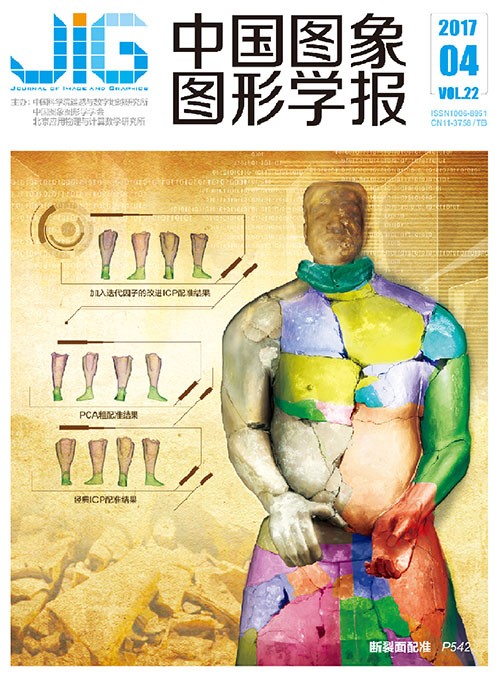
先验模型约束的抗干扰轮廓跟踪
刘大千1, 刘万军2, 费博雯3(1.辽宁工程技术大学电子与信息工程学院, 葫芦岛 125105;2.辽宁工程技术大学软件学院, 葫芦岛 125105;3.辽宁工程技术大学工商管理学院, 葫芦岛 125105) 摘 要
目的 基于水平集的轮廓提取方法被广泛用于运动物体的轮廓跟踪。针对传统方法易受局部遮挡、复杂背景等因素影响的问题,提出一种先验模型约束的抗干扰(AC-PMC)轮廓跟踪算法。方法 首先,选取图像序列的前5帧进行跟踪训练,将每帧图像基于颜色特征分割成若干超像素块,利用均值聚类组建簇集合,并通过该集合建立目标的先验模型。然后,利用水平集分割方法提取目标轮廓,并提出决策判定算法,判断是否需要引入形状先验模型加以约束,避免遮挡、复杂背景等影响。最后,提出一种在线模型更新算法,在特征集中加入适当特征补偿,使得更新的目标模型更为准确。结果 本文算法与多种优秀的轮廓跟踪算法相比,可以达到相同甚至更高的跟踪精度,在Fish、Face1、Face2、Shop、Train以及Lemming视频图像序列下的平均中心误差分别为3.46、7.16、3.82、13.42、14.72、12.47,算法的跟踪重叠率分别为0.92、0.74、0.85、0.77、0.73、0.82,算法的平均运行速度分别为4.27 帧/s、4.03 帧/s、3.11 帧/s、2.94 帧/s、2.16 帧/s、1.71 帧/s。结论 利用目标的先验模型约束以及提取轮廓过程中的决策判定,使本文算法在局部遮挡、目标形变、目标旋转、复杂背景等条件下具有跟踪准确、适应性强的特点。
关键词
Anti-interference contour tracking under prior model constraint
Liu Daqian1, Liu Wanjun2, Fei Bowen3(1.School of Electronic and Information Engineering, Liaoning Technical University, Huludao 125105, China;2.School of Software, Liaoning Technical University, Huludao 125105, China;3.School of Business and Management, Liaoning Technical University, Huludao 125105, China) Abstract
Objective Target tracking plays an important role in computer vision, which is widely applied in intelligent traffic, robot vision, and motion capture. Experts and scholars have proposed numerous excellent target tracking algorithms in recent years to avoid the influence of illumination changes, target deformation, partial occlusion (even global occlusion), complex background, and other factors. One of the popular topics in the field of target tracking is determining how to deal with the change in target contour. A level set can better optimize the topology structure of a target, and thus, many researchers have adopted the level set method for the contour extraction and tracking of targets. In 2004, Freedman used the Bhattacharyya distance and Zhang used the Kullback-Leibler distance in 2005, respectively, to determine the target layout and locate the best candidate region. Accordingly, these researchers combined foreground/background matching flow and proposed a combined flow method. However, these two algorithms depend on the initial target selection. When the initial contour differs from the actual contour of the object, the algorithms will require multiple iterations to converge. Chiverton proposed an online contour tracking algorithm based on the learning model. This algorithm establishes a prior target model through initial target morphology and constrains the contour tracking process by using the target model. Ning proposed an approach that applied the morphological information of the initial delineation of the target to establish the prior model. This researcher also adopted the level set method for the implicit representation of the foreground and background regions of the target information. The distribution area of the foreground/background target is determined using the Bhattacharyya similarity measure to realize accurate tracking. Rathi adopted the geometric active contour model to track a deformed target that was moving fast in the framework of a particle filter. The algorithm does not only achieve affine transformation, but can also accurately estimate the non-affine transform target. The contour extraction methods based on a level set are extensively applied to tracking moving targets. Traditional methods can be easily affected by the local occlusion of other targets and the complex background. A novel tracking approach based on anti-interference contour tracking under the prior model constraint is proposed to solve the aforementioned problems. Method The proposed approach uses a simple model matching algorithm to track the previous five frames of the image sequences. The training sample set is established based on several super pixel blocks obtained via super pixel segmentation. The super pixel block sets with the same color feature are used to establish the cluster sets by using the mean shift algorithm. The confidence probability of each cluster is then calculated, and a prior model of the target is constructed according to the confidence degree of clusters. Subsequently, the target contour is extracted using the segmentation method of the level set. This study proposes a novel decision-making method to avoid the influences of partial occlusion and complex background. This method determines whether a shape prior model is required to constrain the level set evolution process, and thus, obtain more robust tracking results. Lastly, an appearance model online-updating algorithm is proposed. This algorithm can append the appropriate feature compensations to feature sets to improve the updating accuracy of the appearance model. The algorithm uses the evolution results of shape and color features, and then, the feature loss and redundant feature problems are effectively solved when the target is occluded. Result Six sets of common video sequences are used in the test to verify the performance of the proposed algorithm. The video sequence covers challenging factors, such as illumination change, partial occlusion, target deformation, and complex background. The algorithm is also compared with available contour tracking algorithms, such as the density matching and level set, the learning distribution metric, joint registration, and active contour segmentation. The proposed contour tracking algorithm can achieve the same or even higher tracking accuracy compared with excellent contour tracking algorithms. The average center errors in the video sequences Fish, Face1, Face2, Shop, Train, and Lemming are 3.46, 7.16, 3.82, 13.42, 14.72, and 12.47, respectively. The tracking overlap ratios of the aforementioned video sequences are 0.92, 0.74, 0.85, 0.77, 0.73, and 0.82, respectively. The average running speeds in the aforementioned video sequences are 4.27 frame/s, 4.03 frame/s, 3.11 frame/s, 2.94 frame/s, 2.16 frame/s, and 1.71 frame/s, respectively. Conclusion Experiment results indicate that using the prior model constraint of the target and implementing decision-making in the contour extraction process provide the algorithm with accurate tracking and strong adaptability characteristics under the conditions of partial occlusion, target deformation, target rotation, and complex background. The characteristics of the proposed approach are as follows:1) a prior model of the target is built by training the sample set, removing the interference of the non-target information in the image, and providing the prior model with a more accurate description of the target;2) a decision-making method is proposed to judge whether a prior model is required. If the constraints of a prior model must be introduced, then the results of the shape subspace and the evolution in color space are fused in the level set segmentation process;3) an appearance model online-updating algorithm is proposed, which can append the appropriate feature compensations to the feature sets, thereby ensuring the accuracy of the model.
Keywords
|



 中国图象图形学报 │ 京ICP备05080539号-4 │ 本系统由
中国图象图形学报 │ 京ICP备05080539号-4 │ 本系统由